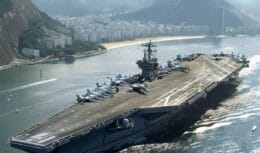
Navigation along the Brazilian coast has an increase in activities one year after the truckers' strike, whose freight tariffs were the main villain
The recent trauma, which occurred last year, when a truck drivers' strike triggered by non-compliance with the diesel price increase policy brought the country to a standstill, made the logistics executives of large companies in Brazil start to look more fondly at other transport options.
Cabotage, as navigation between ports in the country is called, has seen its activities grow due to attempts by companies to sell their products through other modes of transport in an attempt to avoid being left in the hands of truck drivers.
The transport of cargo in containers along the Brazilian coast grew 18% after the truck drivers' strike and every day the modal, cheaper and more reliable, conquers customers from agribusiness to industry. It is worth noting that rail transport also increased by 15%.
The freight tariff measure, imposed by the government, did not prove to be advantageous, as it made freight even more expensive, forcing companies to look for cheaper alternatives.
According to a survey by the Institute of Logistics and Supply Chain (ILOS), since the end of the truck drivers' strike until February this year, there has been a 17,5% growth in the volume of cargo transported by cabotage. In some points, for example, in the northeast-southeast direction, growth was 20%.
Marcos Voloch, director of Mercosur at Aliança Navegação stated that the company's demand has grown by 16% since the stoppage last year and that 192 of the current 1400 customers were conquered in this period.
According to the executive, cabotage was not competitive in several stretches in the country, such as Bahia-São Paulo or Ceará-Bahia, but the adoption of a minimum price for transport by truck ended up giving a new breath to transport by ship.
Road transport system
In national road transport, it is common to have more supply in the direction of going uphill, that is, South-Southeast, Southeast-Northeast and on the way down the truck driver, not having a load to transport (or having a smaller volume) ends up charging less for the freight price.
With the adoption of the minimum freight, negotiation was extinguished and the prices of descent had an incredible 180% increase, as was the case of the Northeast-Southeast stretch.
The small appliance industry in Ceará, Mallory, for example, started to ship 30% of its production by ship. because, according to its director of operations, truck freight from its factory in Maranguape to the road in São Paulo, which used to cost 7 reais, now costs 18.
The executive added that even with road freight being 15% higher than sea freight, road transport bureaucracies are much more uncomplicated, but with increases above 150% it is better to opt for cabotage, despite the delays that may cause release in Brazilian ports.
While the STF does not judge the illegality of the minimum freight table, companies are between a rock and a hard place and are forced to bear extra expenses in the disposal of their productions.








